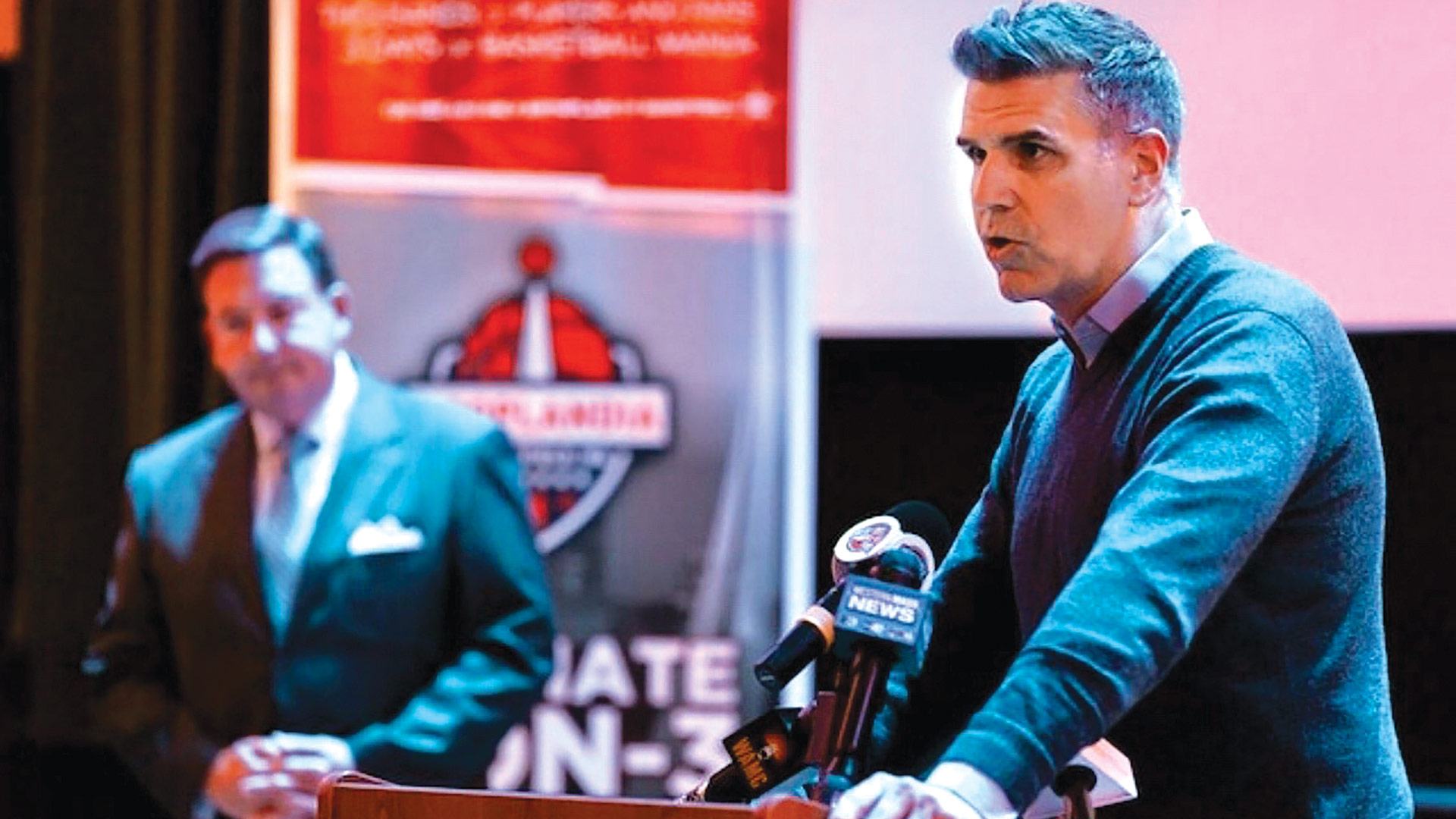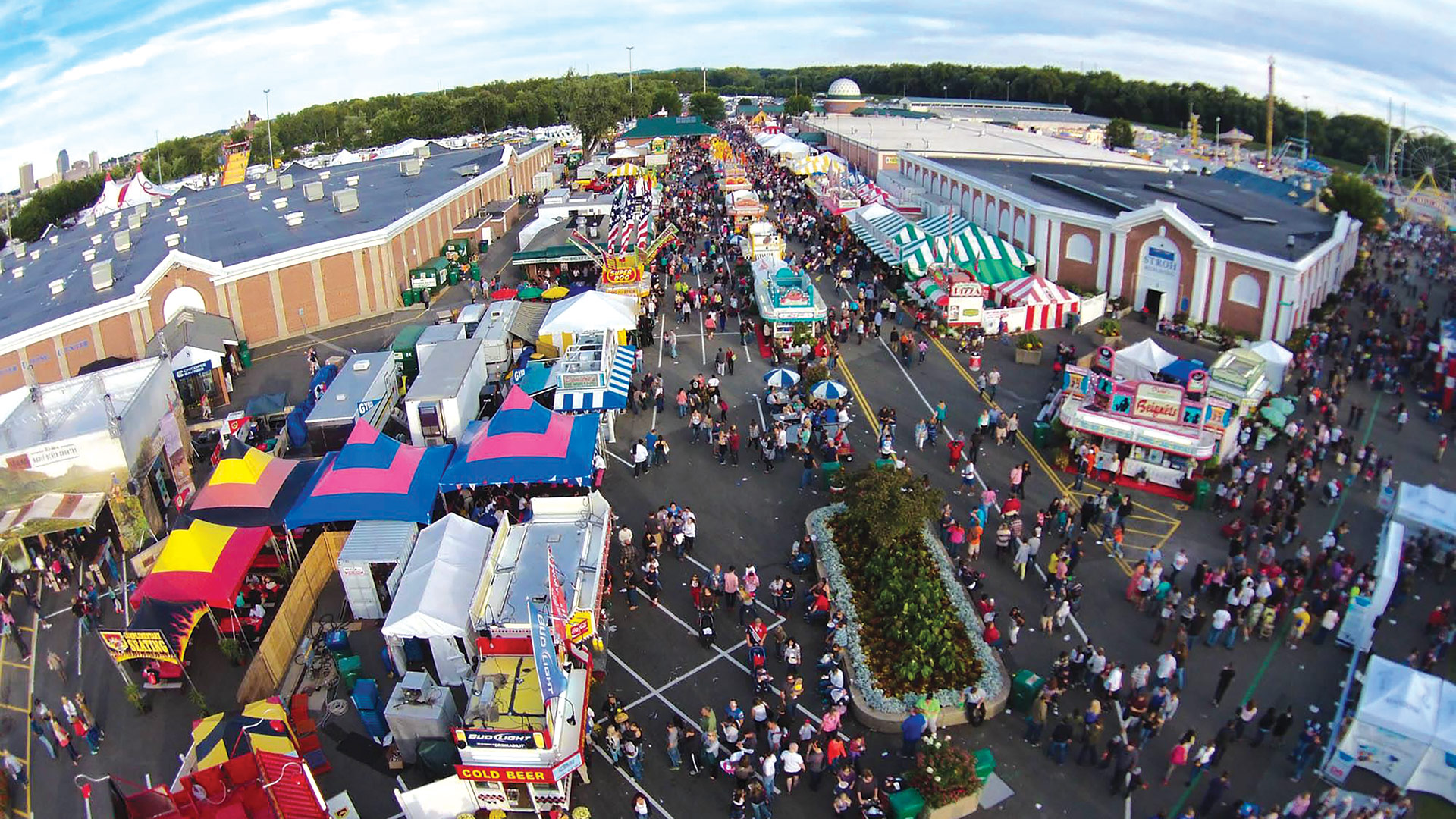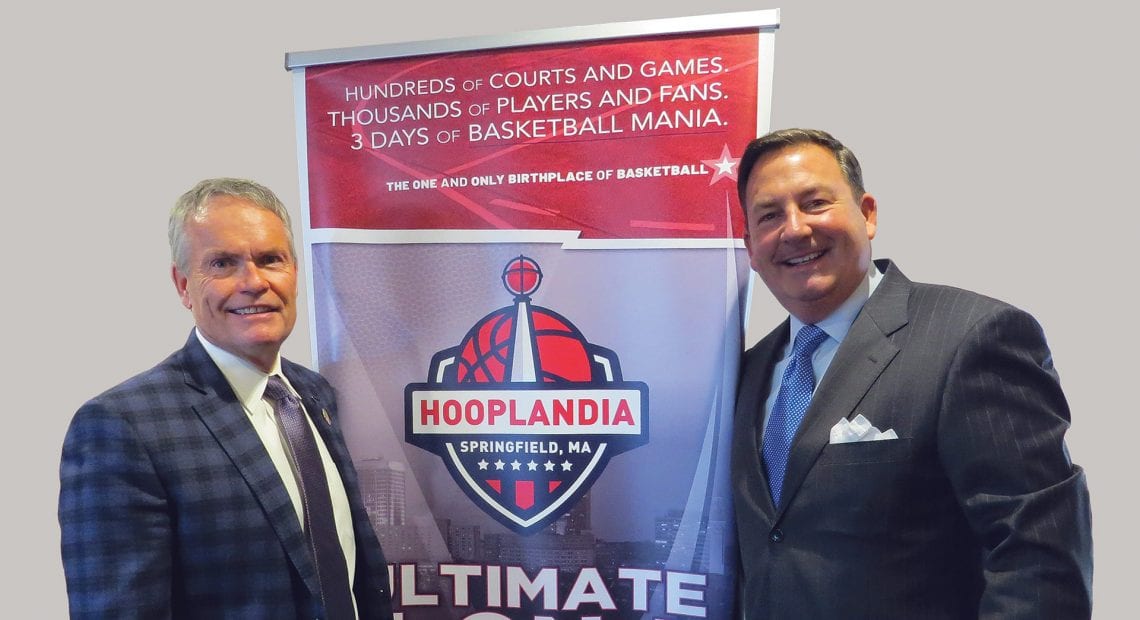Nothing but Net

John Doleva, left, and Eugene Cassidy say Hooplandia could have a huge economic impact on the Greater Springfield region.
One observer referred to Hoopfest, the giant 3-on-3 basketball tournament in Spokane, Wash., as a ‘phenomenon,’ and the adjective fits. The event consumes 40 blocks in the downtown and literally takes over the city each June. Inspired, a group of organizers are looking to do something similar — although Springfield won’t be taken over — in just four months. The event is called Hooplandia, and it’s already being hailed as a slam dunk for the region.
Mark Rivers called it “an a-ha moment.’ Then he quickly amended the phrase in a poignant manner.
“It was an ‘aha/duh!’ moment.”
He was referring to his visit last summer to the giant 3-on-3 basketball tournament in downtown Spokane, Wash., called Hoopfest. And by giant, we mean giant. Indeed, it is billed as the largest event of its kind in the world, and no one doubts that claim. It annually draws more than 7,000 teams, or 28,000 participants (four people to a team on average), and total visitation for the tournament, staged the final weekend in June, approaches 200,000‚ which is roughly the city’s population.
While taking in Hoopfest and marveling at its size and the manner in which it has become synonymous with Spokane, Rivers, an event promoter by trade who has developed strong ties to both the Basketball Hall of Fame and the Big E, had that aforementioned ‘moment,’ during which he concluded that this event, or something like it, would be an even more natural fit in the birthplace of basketball.
“I was thinking, ‘why isn’t there an event like this in Springfield?’”
“I was thinking, ‘why isn’t there an event like this in Springfield?’” he recalled, adding that not only is the city home to the Hall of Fame, it’s located in the heavily populated Northeast, whereas Spokane is in decidedly rural Central Washington.
“It just seemed to make a whole lot of sense,” he went on, adding that what also made sense was to stage the event in the wide-open spaces of the Big E, which has all the needed infrastructure, and also at the Hall of Fame and its Center Court, which would be a special place to play games and act as a magnet for teams around the world.
Fast-forward eight months or so, and Hooplandia, the name chosen for this event, is moving on a fast train toward its June 26-28 debut. Such speed is attainable because of the partners involved — especially the Big E, where most of the games will be staged, and the Hall of Game, which is, indeed, proving to be a strong selling point.

Mark Rivers, seen here at a recent press event announcing Hooplandia, says the gathering has the potential to be a legacy event for the region.
“I’ve already had inquiries from teams in Russia, Belgium, Slovakia, Latvia, Poland, and Brazil,” Rivers explained. “I don’t know if we’ll get teams from all those countries, but we’ve had inquiries — a lot of these teams have expressed an interest in playing in the hometown of basketball and increasing their profile with games in the U.S.”
The goals for this first edition of Hooplandia — and specifically the one for participation (2,500 teams) — are ambitious, said Eugene Cassidy, president and CEO of the Big E, but they are also attainable — and sustainable.
“I firmly believe that, first year out of the box, we can be the second-largest 3-on-3 in the country,” said Cassidy, who experienced Hoopfest while visiting Spokane for a fair-association meeting a few years ago and had the same reaction as Rivers. “And my goal is to supersede Spokane within three to five years.”
Even if the first-year goals are met, or even approached, then Hooplandia could well wind up being one of the biggest single events (the 16-day Big E aside, obviously) the region has seen.
That becomes apparent in the projections for overall economic impact, a formula with a number of factors, including hotel stays, restaurant meals, rental cars, and many others, that Mary Kay Wydra, executive director of the Greater Springfield Convention and Visitors Bureau, describes this way:
“It’s an industry standard, and we use it for all our conventions. We populate different data fields, like the average daily rate they’ll pay, how many people are coming, how many rooms they’ll be utilizing … we put that into the calculator, and it spits out a number for us.”
However the number is derived, for this first edition of Hooplandia, the projected total is roughly $7.3 million. For some perspective, the recently staged Red Sox Winter Weekend, which brought a host of star players, past and present, fans from across the broad Red Sox nation, and a horde of media, was projected to bring in $2 million (the final numbers are still being tabulated). Meanwhile, the AHL All-Star Classic weekend, staged just over a year ago, brought in $2.8 million, according to Wydra, and the much-publicized square-dancing convention in 2015 that brought 4,000 people to Springfield for eight days brought in $2.3 million.
“I firmly believe that, first year out of the box, we can be the second-largest 3-on-3 in the country. And my goal is to supersede Spokane within three to five years.”
“This is certainly about basketball, but it’s also about economic development and tourism,” said John Doleva, president and CEO of the Hall of Fame. “It’s about filling hotel rooms and having people come to the Hall and the Seuss museum and the Armory and local restaurants … this is a multi-day event, and people will stay for the duration and perhaps longer.”
For this issue and its focus on meetings and conventions, BusinessWest takes an in-depth look at Hooplandia, what it can become, and what it might mean to the region.
Court of Opinion
Rivers calls it “getting the plane off the ground.”
That’s an industry phrase of sorts for launching an event of this magnitude. It’s never easy, he said, but with Hooplandia, there are a number of factors contributing to make it somewhat easier.
Especially the ability to stage this huge event at the Big E, a place — and a business — that’s well-versed in hosting large events, everything from the fair itself to a wide range of shows and competitions that fill the calendar.
To help explain, Rivers first referenced Hoopfest, which, essentially takes over downtown Spokane for three days, shutting down roughly 40 blocks in the heart of the city, a logistically difficult and expensive undertaking.
“Typically, when an event like this comes together, you do have a hard time getting the plane off the ground because your first expenses are renting port-a-potties, tents and road barricades, permits, shutting down streets, and doing all those things,” he went on. “You won’t have to do any of those at the fairgrounds, so it just seemed like a natural fit.”
Indeed, the majority of Hooplandia’s thousands of individual games will take place on the roads within the Big E’s 39 acres, although some will be played in its historic Coliseum, said Cassidy, adding that there is infrastructure in place to effectively handle the teams, spectators, media, and anyone else who descends on the area.
“We can handle large numbers of people; we have the capacity to host huge events — it’s what we do,” he said, adding that he has always viewed the Big E as an economic driver for the region — again, not just with the annual fair but all the events staged there — and Hooplandia provides another opportunity to build upon that role.
At the same time, the event provides an opportunity to further leverage basketball for the benefit of the region’s economy.
“It occurred to me that basketball should be an economic growth industry for Springfield,” he noted. “Hooplandia can help drive attendance to the Hall, drive awareness, and build the brand of basketball in the city where it was invented.”
Planning continues for the event, which, as noted earlier, has the ambitious goal of attracting 2,500 teams. And these teams will cover a broad spectrum, said all those we spoke with, adding that this will differentiate this tourney and festival from some others like it and add to its already strong drawing power.

Mark Rivers says the Big E’s vast spaces and deep infrastructure will help ‘get the plane off the ground’ when it comes to Hooplandia.
Indeed, there will be divisions for youths, high-school and college players, professionals, first responders, veterans, military, wheelchair, Special Olympics, and more, said Rivers.
There will also be an under-8, or U8, division, for which entrance fees will be waived in honor of the late Kobe Bryant, the former NBA superstar who died in a recent helicopter crash (and wore number 8 in his playing days).
In addition to the hoop tournaments, a number of other activities are on the agenda, many to take place the Friday night before the playing starts in the Coliseum, said Doleva. These include slam dunk, 3-point shot, free throw, full-court shot, dribble course, and vertical jump competitions.
To date, several partners have signed on, including Chevrolet, the first national-level sponsor, as well as USA Basketball, Springfield College, and Boys & Girls Clubs, which Hooplandia has designated as its charitable partner, offering financial support and playing opportunities for boys and girls in the region. For more information, visit www.hooplandia.com.
Overall, in the opinion of those now planning it, this is the right event at the right time, and the right city (or region), and we’ll address each of those in turn.
Actually, the first two go together. The event is 3-on-3 basketball, and the timing could not be better, because the sport — already described as the largest urban team sport in the world in one study — is enjoying a surge in popularity, said Doleva, with new leagues such as Big3, a league founded by Ice Cube featuring mostly former NBA stars.
And it will almost certainly enjoy another growth spurt after the Summer Olympics in Tokyo, where 3-on-3 basketball will make its debut as an Olympic sport.
“3-on-3 has become sort of the hot segment of the sport, and for a bunch of reasons,” said Rivers. “The Olympics is part of it, but beyond that, 3-on-3 makes the sport more accessible because you only need six players, and you only need half a court; it’s particularly hot in Europe, and many of the best teams come from former Soviet Bloc countries — that’s where a lot of the great ball is being played.”
As for the place, as Rivers and others noted, Springfield, and in this case Greater Springfield (the Big E is across the river), is a natural location.
Not only it is the home of the game and its Hall of Fame, but it’s located in the Northeast, two hours from New York, 90 minutes from Boston, and well within reach of a number of large metropolitan areas.
And, as noted, some of those great teams from Europe — and individuals from across the country — are already expressing interest in playing on what could truly be called the sport’s home court.
A Slam Dunk
This brings us back to those projections about overall economic impact. The numbers are still being crunched and there are a number of factors that go into the final projection, said Wydra, but at the moment, the number is $7 million.
That’s based on the assumption that, while many participating teams will be local, meaning they will drive to and from the Big E each day to compete, a good number — again, just how many is not yet known — will have to travel into the region and stay a few nights.
At the moment, the projected number of hotel-room nights is 1,500, said Wydra. Again, to put things in perspective, there were 840 room nights for Red Sox Winter Weekend and 4,666 for the square-dance convention, and for Hall of Fame induction ceremonies, the number varies depending on who is being inducted, but the 2019 edition had 850.
And for Hooplandia, these room nights will be coming at an important time for the region’s hospitality-related businesses, she went on, adding that the college-graduation season will have ended, but summer won’t be in highest gear.
“I love the timing — school is just out, and people have the ability to travel,” she said. “The other good thing about the June weekend is that Six Flags is up and running, and we have a lot of things for people to do when they’re not at the event. You bring people in for specific purpose, but if we can expose them to other things, we have the ability to bring them back again as a leisure visitor, and that’s very important.”
Wydra said that a now-former member of her team had a chance to observe and absorb Hoopfest first-hand — and somewhat by accident.
Coincidentally, Spokane was hosting the square-dance convention mentioned earlier the year before Springfield was scheduled to do so — and on the same weekend as Hoopfest. The GSCVB had someone on hand to observe the dance gathering and promote the following year’s edition.
But while doing so, she got a good taste of the reach — and the deep impact — of the 3-on-3 festival.
“I remember her calling in and us asking about the square-dance event, and she said, ‘the city’s been taken over by this massive basketball event, and everywhere you look there’s basketball courts, traffic’s been rerouted … it’s huge.”
It won’t be quite like that in Greater Springfield because the event will mostly take place at the Big E. But the impact will be significant, and the region — and especially its hospitality sector — will know that there are thousands of people in the area to play 3-on-3 basketball.
And organizers say it has the potential to not only reach the size of Hoopfest in terms of teams and visitation, but perhaps match it in terms of impact and providing an identity for the region — which would be saying something given what the Spokane event has become.
“Hoopfest is truly part of the culture of that community,” said Rivers. “Hoopfest is to Spokane what the Tournament of Roses is to Pasadena — it’s the fair-haired community phenomenon of that region, and it’s wonderfully done.
“With Hooplandia, I believe we have the makings of a true legacy event, something that could last for decades, much like Hoopfest,” he went on. “I think it will have meaningful, long-lasting economic impact, and I also think that, over the years, it will become a week in June that will be about more than basketball — it will be a week-long celebration of the sport.”
Cassidy agreed. While in Spokane, he saw and heard that the city referred to itself as ‘Hoop Town USA,’ and has trademarked that brand. “Quite honestly, I was offended by that,” he told BusinessWest, noting that Springfield should have that designation. With Hooplandia, hopefully it will — trademark aside.
Getting a Bounce
Returning to Spokane one last time, figuratively, anyway, Rivers described it as a “phenomenon.”
“It’s unbelievable … you can’t get a hotel room, you can’t get a rental car, you can’t get a dinner reservation,” he said. “It’s exciting, and it’s fun.”
Whether Hooplandia can approach that same kind of impact remains to be seen, but all those involved believe it has the potential to be, as they say in this sport, a slam dunk.
Or, as Rivers and others said, a legacy event for this region.
George O’Brien can be reached at [email protected]






